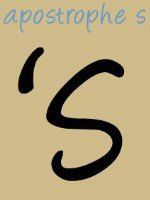apostrophe and ‘s’
 The incorrect use of the the placement of an apostrophe and ‘s’ is another of many English grammar nerds’ pet peeves. People are uncertain about when to use an apostrophe – which is a punctuation mark – because they apostrophes are used for two different purposes, and there are many sub-rules within the two usage categories that tell you whereabouts in the word that you place the apostrophe. The placement of the apostrophe and ‘s’ causes particular problems, especially for English language learners.
The incorrect use of the the placement of an apostrophe and ‘s’ is another of many English grammar nerds’ pet peeves. People are uncertain about when to use an apostrophe – which is a punctuation mark – because they apostrophes are used for two different purposes, and there are many sub-rules within the two usage categories that tell you whereabouts in the word that you place the apostrophe. The placement of the apostrophe and ‘s’ causes particular problems, especially for English language learners.
An apostrophe and ‘s’
- shows possession;
- is used as a contraction.
apostrophe and ‘s’ – where and how it’s used.
The possessive use of the apostrophe and ‘s’
This is also called the s possessive. When you want to show that something belongs to, or is somehow related to, someone or something, you use an apostrophe.
“This is the shirt belonging to May.”
“This is May’s shirt”
Single nouns.
The positioning of the apostrophe for singular nouns and most personal or proper names is before the s. Place the apostrophe and then the ‘s.’ When personal or proper names end in ‘s,’ the accepted practice is to add the apostrophe and then add another ‘s,’ if you would actually say it like this, and pronounce that extra ‘s.’
“James’s job is very exciting.”
There are some exceptions to the apostrophe placement in personal and proper names that end with ‘s,’ and these are guided by how you pronounce the word to imply the possessive. If the second ‘s’ is not actually spoken, don’t add it, but leave the apostrophe AFTER the ‘s’:
“Maria Callas’ voice is the best ever in the history of opera.”
Generally speaking, if the word ends with a hard s sound (like a Z), add the extra ‘s’ after the apostrophe at the end of the hard ‘s.’ If the word ends with a soft ‘s,’ drop the second ‘s’ after the apostrophe.
Plural nouns
If the plural word already ends in an ‘s’, just add the apostrophe after it.
“The girls’ hockey team is very good.”
If the noun does not end with an ‘s,’ place the apostrophe before the ‘s’ at the end.
“The pelican’s beak is very large.”
Note that you do not use apostrophes with possessive pronouns such their, yours, his.
Contractions, the apostrophe and ‘s’
The second major use of apostrophe and ‘s’ is to show omission, and by this we mean that we create one word from two, losing one or more letters to produce, with the placing of an apostrophe, a contraction.
“It’s been a good evening.”
“It has been a good evening.”
“He would’ve like to be there.”
“He would have liked to be there.”
Its or it’s?
The rules for using an apostrophe and ‘s’ with the word ‘it’ observes the following rules. When its is a contraction , as shortening of the two words ‘it is’, use an apostrophe.
When its implies possession, do NOT use an apostrophe.
“Its name is Bob.”
To conclude – an apostrophe and ‘s’ either: shows possession; of, is used as a contraction.




















